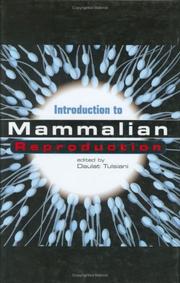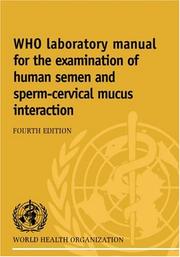| Listing 1 - 7 of 7 |
Sort by
|
Book
Abstract | Keywords | Export | Availability | Bookmark
 Loading...
Loading...Choose an application
- Reference Manager
- EndNote
- RefWorks (Direct export to RefWorks)
Cervix mucus --- Semen --- Sperm-ovum interactions --- Cervix Mucus --- Spermatozoa --- Sperm-Ovum Interactions --- Examination --- Laboratory manuals --- chemistry
Dissertation
Abstract | Keywords | Export | Availability | Bookmark
 Loading...
Loading...Choose an application
- Reference Manager
- EndNote
- RefWorks (Direct export to RefWorks)
Coitus --- Sexual Behavior --- Infertility --- Sperm-Ovum Interactions --- psychology --- diagnosis

ISBN: 140207283X Year: 2003 Publisher: Dordrecht ; Boston, MA ; London : Kluwer,
Abstract | Keywords | Export | Availability | Bookmark
 Loading...
Loading...Choose an application
- Reference Manager
- EndNote
- RefWorks (Direct export to RefWorks)
Embryo implantation --- Fertilization --- Ovum --- Reproductive techniques --- Sperm capacitation --- Sperm-ovum interactions --- Spermatozoa

ISBN: 0521645999 Year: 1999 Publisher: Cambridge Cambridge University Press
Abstract | Keywords | Export | Availability | Bookmark
 Loading...
Loading...Choose an application
- Reference Manager
- EndNote
- RefWorks (Direct export to RefWorks)
Gynaecology. Obstetrics --- Semiology. Diagnosis. Symptomatology --- Urology. Andrology --- Cervix mucus --- Semen --- Sperm-ovum interactions --- Cervix Mucus --- Sperm-Ovum Interactions --- Spermatozoa --- Examination --- Laboratory manuals. --- chemistry --- Chemistry --- SEMEN --- SPERMATOZOA --- CERVIX MUCUS --- SPERM --- CHEMISTRY LABORATORY MANUALS --- OVUM INTERACTIONS LABORATORY MANUALS
Book
ISBN: 9240686282 9240030786 9241547782 Year: 2010 Publisher: Geneva : World Health Organization,
Abstract | Keywords | Export | Availability | Bookmark
 Loading...
Loading...Choose an application
- Reference Manager
- EndNote
- RefWorks (Direct export to RefWorks)
Semen analysis may be useful in both clinical and research settings for investigating male fertility status as well as monitoring spermatogenesis during and following male fertility regulation and other interventions. This manual provides updated standardized evidence-based procedures and recommendations for laboratory managers scientists and technicians to follow in examining human semen in a clinical or research setting. Detailed protocols for routine optional and research tests are elaborated. The fifth edition includes new information on sperm preparation for clinical use or specialized as
Cervix Mucus -- chemistry -- Laboratory Manuals. --- Semen -- Analysis -- Laboratory manuals. --- Semen -- chemistry -- Laboratory Manuals. --- Spermatozoa -- chemistry -- Laboratory Manuals. --- Sperm-Ovum Interactions -- Laboratory Manuals. --- Semen --- Germ Cells --- Natural Science Disciplines --- Mucus --- Fertilization --- Bodily Secretions --- Cells --- Reproduction --- Fluids and Secretions --- Genitalia --- Reproductive Physiological Processes --- Anatomy --- Urogenital System --- Reproductive Physiological Phenomena --- Reproductive and Urinary Physiological Phenomena --- Cervix Mucus --- Spermatozoa --- Chemistry --- Sperm-Ovum Interactions --- Medicine --- Health & Biological Sciences --- Pathology --- Analysis --- Germ Cells. --- Natural Science Disciplines. --- Mucus. --- Fertilization. --- Bodily Secretions. --- Cells. --- Reproduction. --- Fluids and Secretions. --- Genitalia. --- Reproductive Physiological Phenomena. --- Anatomy. --- Urogenital System. --- Reproductive and Urinary Physiological Phenomena. --- Semen. --- Cervix Mucus. --- Spermatozoa. --- Chemistry. --- Sperm-Ovum Interactions.
Book
ISBN: 3319305654 3319305670 Year: 2016 Publisher: Cham : Springer International Publishing : Imprint: Springer,
Abstract | Keywords | Export | Availability | Bookmark
 Loading...
Loading...Choose an application
- Reference Manager
- EndNote
- RefWorks (Direct export to RefWorks)
Over the last decades, acrosomal exocytosis (also called the “acrosome reaction”) has been recognized as playing an essential role in fertilization. Secretion of this granule is an absolute requirement for physiological fertilization. In recent years, the study of mammalian acrosomal exocytosis has yielded some major advances that challenge the long-held, general paradigms in the field. Principally, the idea that sperm must be acrosome-intact to bind to the zona pellucida of unfertilized eggs, based largely on in vitro fertilization studies of mouse oocytes denuded of the cumulus oophorus, has been overturned by experiments using state-of-the-art imaging of cumulus-intact oocytes and fertilization experiments where eggs were reinseminated by acrosome-reacted sperm recovered from the perivitelline space of zygotes. From a molecular point of view, acrosome exocytosis is a synchronized and tightly regulated process mediated by molecular mechanisms that are homologous to those reported in neuroendocrinal cell secretions. The authors provide a broader perspective, focusing on a limited number of important topics that are essential for understanding the molecular mechanisms governing this step in the fertilization process. They also discuss molecular aspects such as the signaling pathways leading to exocytosis, including the participation of ion channels, lipids, the fusion machinery proteins and the actin cytoskeleton as well as cellular aspects such as the site of acrosomal exocytosis and the use of gene-manipulated animals to study this process. .
Medicine. --- Human physiology. --- Molecular biology. --- Reproductive medicine. --- Urology. --- Biomedicine. --- Human Physiology. --- Molecular Medicine. --- Reproductive Medicine. --- Spermatozoa. --- Fertilization (Biology) --- Acrosome reaction. --- Acrosomal reaction --- Reaction, Acrosome --- Amphimixis --- Male gametes --- Sperm --- Medicine --- Genitourinary organs --- Human reproduction --- Human reproductive health --- Human reproductive medicine --- Reproductive medicine --- Health --- Molecular biochemistry --- Molecular biophysics --- Biochemistry --- Biophysics --- Biomolecules --- Systems biology --- Human biology --- Medical sciences --- Physiology --- Human body --- Clinical sciences --- Medical profession --- Life sciences --- Pathology --- Physicians --- Diseases --- Health aspects --- Chemical reactions --- Sperm-ovum interactions --- Spermatozoa --- Biology --- Cells --- Embryology --- Reproduction --- Gametes --- Semen --- Health Workforce --- Reproductive health. --- Biomedical Research. --- Research. --- Biological research --- Biomedical research
Book
ISBN: 1441917810 9786613476715 1441968571 1283476711 Year: 2011 Publisher: New York : Springer,
Abstract | Keywords | Export | Availability | Bookmark
 Loading...
Loading...Choose an application
- Reference Manager
- EndNote
- RefWorks (Direct export to RefWorks)
Sperm DNA damage is common and has been associated with reduced rates of conception, impaired embryonic development and increased risk of miscarriage. Although the exact causes of sperm DNA damage are unknown, it is clear that infertile men possess substantially higher levels of sperm DNA damage than do fertile men. Written by leading, internationally renowned clinicians and basic scientists with expertise in sperm DNA, Sperm Chromatin: Biological and Clinical Applications in Male Infertility and Assisted Reproduction provides readers with a thoughtful and comprehensive review of the biological and clinical significance of sperm DNA damage. The work covers the fundamental principles of sperm chromatin architecture and function, the proposed modes of DNA damage and repair, the tests of sperm DNA damage, the clinical aspects of DNA damage and the impact of DNA damage on reproductive outcome. Unlike any other title on the topic, Sperm Chromatin: Biological and Clinical Applications in Male Infertility and Assisted Reproduction is an invaluable addition to the literature and will serve as an indispensable resource for basic scientists with an interest in sperm biology and for urologists, gynecologists, reproductive endocrinologists, and embryologists working in the field of infertility.
Chromatin. --- Semen -- chemistry. --- Spermatozoa -- chemistry. --- Sperm-Ovum Interactions. --- Spermatogenesis --- Infertility, Male --- Sex chromatin --- Germ Cells --- Chromosome Structures --- Infertility --- Medicine --- Genetic Processes --- DNA Packaging --- Biological Science Disciplines --- Gene Expression Regulation --- Nucleoproteins --- Genitalia --- Genetic Structures --- Cells --- Proteins --- Genetic Phenomena --- Health Occupations --- Natural Science Disciplines --- Cell Physiological Processes --- Genital Diseases, Male --- Chromosomes --- Anatomy --- Male Urogenital Diseases --- Amino Acids, Peptides, and Proteins --- Intranuclear Space --- Urogenital System --- Phenomena and Processes --- Cell Physiological Phenomena --- Disciplines and Occupations --- Diseases --- Cell Nucleus Structures --- Chemicals and Drugs --- Cell Nucleus --- Intracellular Space --- Cellular Structures --- Spermatozoa --- Physiology --- Chromatin --- Chromatin Assembly and Disassembly --- Pathology --- DNA Damage --- Zoology --- Health & Biological Sciences --- Gynecology & Obstetrics --- Animal Anatomy & Embryology --- Genetic aspects --- Infertility, Male. --- Human reproductive technology. --- Spermatozoa. --- Male gametes --- Sperm --- Assisted human reproduction --- Assisted conception --- Conception --- Human assisted reproduction --- Human reproduction --- Male infertility --- Male sterility --- Sterility, Male --- Technological innovations --- Medicine. --- Obstetrics. --- Endocrinology. --- Reproductive medicine. --- Urology. --- Cell biology. --- Developmental biology. --- Medicine & Public Health. --- Reproductive Medicine. --- Developmental Biology. --- Cell Biology. --- Obstetrics/Perinatology. --- Gametes --- Semen --- Medical technology --- Reproductive technology --- Generative organs, Male --- Cytology. --- Obstetrics/Perinatology/Midwifery. --- Genitourinary organs --- Maternal-fetal medicine --- Cell biology --- Cellular biology --- Biology --- Cytologists --- Development (Biology) --- Growth --- Ontogeny --- Internal medicine --- Hormones --- Human reproductive health --- Human reproductive medicine --- Reproductive medicine --- Health --- Health aspects --- Endocrinology .
| Listing 1 - 7 of 7 |
Sort by
|

 Search
Search Feedback
Feedback About UniCat
About UniCat  Help
Help News
News